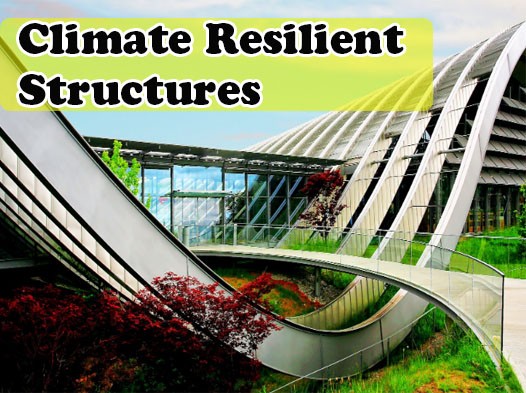Climate change is one of the most pressing global issues facing our planet today.
The increase in extreme weather events, such as heatwaves, floods, hurricanes, and droughts, has highlighted the urgent need for sustainable and resilient infrastructure. Climate resilient structures are a crucial component of such infrastructure, as they are designed to withstand the impacts of extreme weather events. Additionally, they promote energy efficiency, sustainability, and occupant comfort.
In this article, we will explore the concept of climate resilient structures, their benefits, and the challenges of building them. We will also discuss the importance of developing standardized guidelines and policies to incentivize the adoption of climate resilient design strategies.
Climate Resilient Structure: What Is It?
Climate change is a reality that affects all aspects of our lives, including the built environment. It has become increasingly important to design and construct structures that are resilient to the changing climate. Climate resilience is the ability of a structure to withstand and adapt to the impacts of climate change while maintaining its functionality and structural integrity.
Characteristics of a Climate Resilient Structure
A climate resilient structure is designed and constructed to reduce its vulnerability to extreme weather events such as hurricanes, flooding, droughts, heatwaves, and wildfires. It is also designed to be adaptable to changes in temperature, precipitation, and sea level rise over the structure’s lifespan.
To achieve climate resilience, a structure must possess certain characteristics, including:
- Robustness – The ability to withstand extreme weather events without significant damage to the structure’s structural integrity.
- Redundancy – The presence of backup systems and resources to maintain critical functions of the structure during and after extreme weather events.
- Resourcefulness – The capacity to adapt to changing environmental conditions, such as temperature, humidity, and precipitation, to maintain the functionality of the structure.
- Flexibility – The ability to modify or adjust the structure’s design to adapt to changing environmental conditions, such as sea level rise, increased precipitation, or temperature extremes.
5 Ways to Build Climate Resilient Structures
Building a climate resilient structure involves implementing various strategies that reduce its vulnerability to extreme weather events and make it adaptable to changes in the environment. Here are some strategies for building a climate resilient structure:
01. Site Selection and Building Orientation
The first step in building a climate resilient structure is choosing a suitable site and orientation. The site selection process should consider factors such as the location of flood zones, storm surge zones, and wildfire-prone areas. The structure should also be oriented to maximize its exposure to sunlight and wind to reduce energy consumption and improve indoor air quality.
02. Building Envelope Design
The building envelope is the physical barrier that separates the interior and exterior of a structure. It includes walls, roofs, windows, and doors. A climate resilient structure should have a well-designed building envelope that can withstand extreme weather events and maintain indoor comfort. The building envelope should be airtight and well-insulated to reduce energy consumption and minimize heat loss and gain.
03. Insulation and Ventilation
A climate resilient structure should have adequate insulation to reduce energy consumption and maintain indoor comfort. The insulation material should be resistant to moisture and mold growth to prevent structural damage and indoor air pollution. Ventilation systems should be designed to provide fresh air while controlling indoor humidity levels to prevent moisture buildup.
04. Use of Sustainable and Recyclable Materials
Sustainable and recyclable materials should be used in the construction of a climate resilient structure. These materials should be locally sourced to reduce transportation costs and minimize the carbon footprint. They should also be durable, long-lasting, and require low maintenance to reduce the need for frequent repairs and replacements.
05. Landscaping and Stormwater Management
Landscaping and stormwater management are essential components of a climate resilient structure. Landscaping should be designed to maximize the infiltration of rainwater into the soil, reduce the heat island effect, and improve air quality. Stormwater management systems should be designed to control runoff and prevent flooding and erosion.
This is a practical guide from the UNEP publication that can give a comprehensive idea of climate resilient buildings.
The Benefits of Climate Resilient Structures
Building a climate resilient structure has numerous benefits that go beyond safety and comfort. Here are some of the benefits of building a climate resilient structure:
- Reduced Energy Consumption
A climate resilient structure is designed to minimize energy consumption by reducing the need for heating, cooling, and lighting. The use of sustainable materials, insulation, and ventilation systems reduces the energy required to maintain indoor comfort, resulting in lower energy bills.
- Improved Indoor Air Quality
A climate resilient structure is designed to promote good indoor air quality by providing fresh air and controlling humidity levels. This helps to prevent the growth of mold and mildew, which can cause respiratory problems and other health issues.
- Increased Property Value
A climate resilient structure is an investment in the long-term value of a property. Such a structure is designed to withstand extreme weather events, reducing the risk of damage and the need for costly repairs. Additionally, a climate resilient structure is an attractive feature for potential buyers, which increases the property’s value.
- Enhanced Comfort and Safety
A climate resilient structure provides comfort and safety to its occupants by maintaining indoor comfort and reducing the risk of damage and injury during extreme weather events. This promotes a healthy and secure living environment for the occupants.
- Reduced Environmental Impact
A climate resilient structure is designed to minimize its environmental impact by reducing energy consumption and using sustainable materials. This helps to reduce greenhouse gas emissions, conserve natural resources, and promote sustainable living practices.
The Challenges of Building Climate Resilient Structures
Building a climate resilient structure presents various challenges that must be addressed during the design and construction phases. Here are some of the challenges of building a climate resilient structure:
- Cost
Building a climate resilient structure can be costly due to the use of specialized materials and the implementation of advanced design strategies. However, the initial cost can be offset by long-term savings in energy consumption and reduced maintenance costs.
- Design Complexity
Building a climate resilient structure requires a thorough understanding of the site-specific environmental conditions, which can be complex and variable. The design process must account for these conditions and incorporate strategies that reduce the structure’s vulnerability to extreme weather events.
- Construction Techniques
Building a climate resilient structure requires specialized construction techniques that may not be familiar to traditional builders. This requires training and education for builders and contractors to ensure that the techniques are implemented correctly.
- Lack of Standards
There are currently no standardized guidelines or codes for building climate resilient structures. This can result in inconsistencies in design and construction practices, making it difficult to compare and evaluate different structures.
- Regulatory Barriers
The existing regulatory framework may not always support the construction of climate resilient structures. Regulations may be outdated or lack incentives for implementing climate resilient design strategies.
Some Cost-Effective Examples of Climate Resilient Structures
Now that you have learned a lot about climate resilient structures, let’s take a look at some of the examples. These examples are very cost-effective and they are effective in preventing catastrophic damages.
They don’t have to be expensive, difficult, or require a lot of technology. In reality, a lot of them are based on naturally occurring solutions or just natural solutions, with frequently minimal costs.
Without further ado, let’s look at the first example.
Mangrove Forest
Mangroves are an excellent illustration of how cities should prepare for extreme weather occurrences like hurricanes. This type of environment and flora, which has received a lot of criticism in recent years, has turned out to be the finest wavebreaker conceivable. In actuality, Xbloc units are much inferior to the concrete used in ports and dikes. A city will be better able to withstand abrupt surges if its mangroves are preserved or restored. Tanzania’s and Kenya’s coasts serve as illustrations of proactive protective measures.

City with Enough Plantation
A city that has cultivated dense, lush, and luxuriant vegetation will be better equipped to weather the scorching summers. Planting trees and plants will moderate the temperature, offer shade, and increase evapotranspiration. This will prevent heatstroke deaths and unnecessarily high energy demand. The species in the environment will also be safeguarded. In fact, this is resilience’s defense against events. One of the cities with the most productive green spaces is Singapore.

Sponge Cities
A city increases the number of its green spaces so that there are many places to flee from cyclical inflows of water. Sponge cities work like that. Cities may be more easily drained by expanding the land area (the area of organic soil, not the size of paved surfaces). The sewage system won’t get saturated during the floods, and the water will fill the aquifers. One of the places where this is most prevalent is the city of Zhengzhou.

Conclusion
The increasing frequency and severity of extreme weather events are highlighting the need for climate resilient structures. Therefore, building a climate resilient structure is an investment in the long-term value of a property and the well-being of its occupants.
With proper planning, implementation, and support, climate resilient structures can promote sustainability, resilience, and comfort in the face of extreme weather events.

